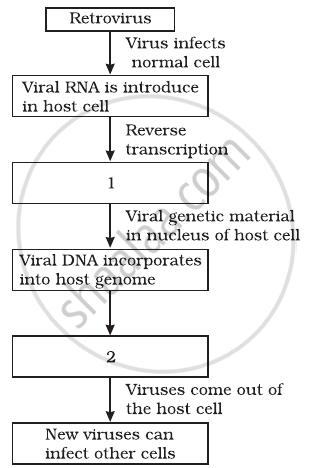Advertisements
Advertisements
Question
How is a cancerous cell different from a normal cell?
Solution
| Normal cell | Cancerous cell | |
| 1. | Normal cells show the property of contact inhibition. Therefore, when these cells come into contact with other cells, they stop dividing. | Cancerous cells lack the property of contact inhibition. Therefore, they continue to divide, thereby forming a mass of cells. |
| 2. | They undergo differentiation after attaining a specific growth. | They do not undergo differentiation. |
| 3. | These cells remain confined at a particular location. | These cells do not remain confined at a particular location. They move into neighbouring tissues and disturb their function. |
| 4. | Dividing cells remain confined to the part of the body where they are formed. | These cells show metastasis, i.e., they have the ability to invade new sites. |
| 5. | Cells require extracellular growth factors. |
These do not require extracellular growth factors. |
| 6. | Tumours are not formed. | They tend to form tumours. |
| 7. | Normal cells have a definite life span. |
Cancer cells do not have a definite life span and resist the induction of cell death, which promotes tumour development. |
APPEARS IN
RELATED QUESTIONS
Cancer is one of the most dreaded diseases. Explain 'Contact inhibition' and 'Metastasis' with respect to the disease
Name any two techniques that are useful in detecting cancers of internal organs.
What is a carcinogen?
What is cancer?
Carcinoma is cancer of ______ cells.
Inactive gene that can cause cancer is called ______.
- How is a tumor formed in the body?
- What are the two types of tumor?
- Which of these under goes metastasis?
Explain any four therapies used in treatment of cancer.
Cancer cells are more easily damaged by radiations than normal cells because they are ______.
Metastasis is associated with ______.
In leukemia both WBCs and RBCs increase in number.
What is metastasis?
Cancer is related to ______
AIDS is caused by HIV. Among the following, which one is not a mode of transmission of HIV?
The immune system of a person is suppressed. In the ELISA test, he was found positive to a pathogen.
- Name the disease the patient is suffering from.
- What is the causative organism?
- Which cells of body are affected by the pathogen?
In the given flow diagram, the replication of retrovirus in a host is shown. Observe and answer the following questions.
Fill in (1) and (2)
Why is the virus called retrovirus?
Can the infected cell survive while viruses are being replicated and released?

Genes involved in cancer are ______.
Cancer is generally caused due to activation of ______ to ______ and/or inactivation of ______.
The interferons are ______.
Which one of the following diseases is non - communicable?
